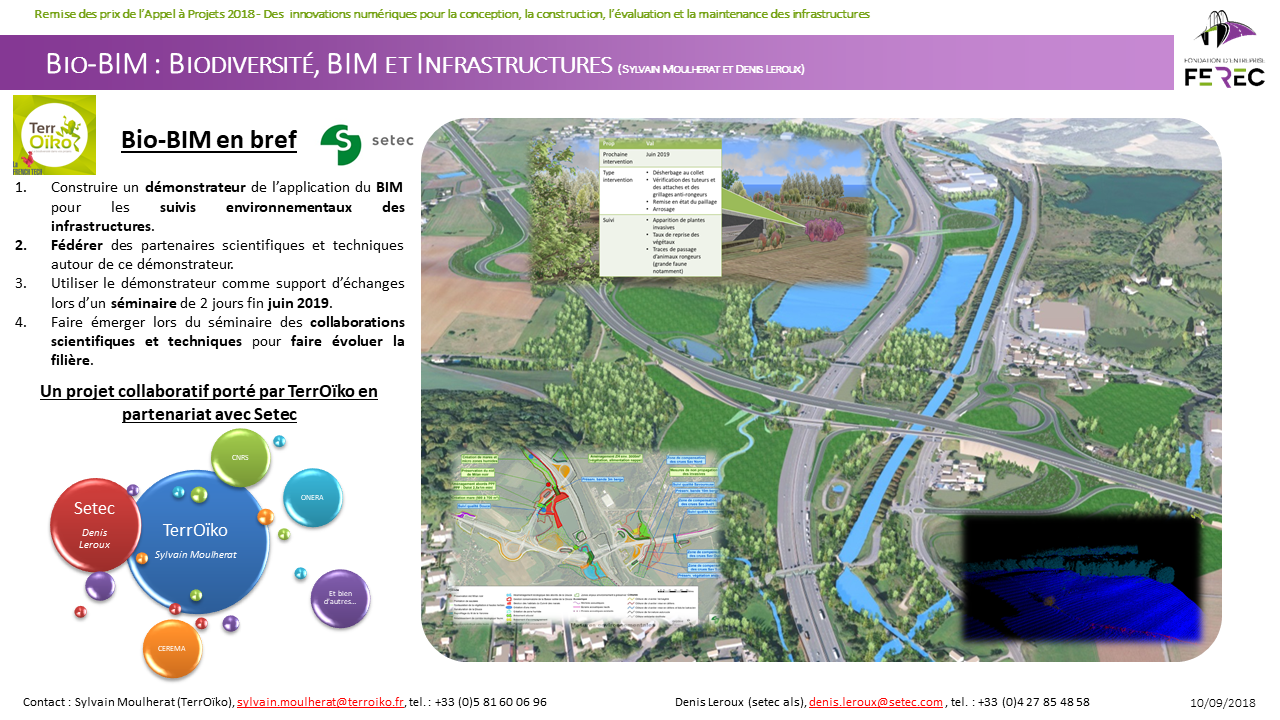 The BioBIM project, led by TerrOïko and Setec ALS, aimed to inform transport infrastructure stakeholders involved in environmental management about the opportunities presented by the digital transition in their activities. Through the development of a collaborative demonstrator on a concrete pilot site and the organization of the OïkoLab workshop seminar, the project addressed the integration of digital technologies for managing environmental and compensatory measures (avoid-reduce-compensate sequence) into Building Information Modeling (BIM) tools applied to infrastructure.
The BioBIM project, led by TerrOïko and Setec ALS, aimed to inform transport infrastructure stakeholders involved in environmental management about the opportunities presented by the digital transition in their activities. Through the development of a collaborative demonstrator on a concrete pilot site and the organization of the OïkoLab workshop seminar, the project addressed the integration of digital technologies for managing environmental and compensatory measures (avoid-reduce-compensate sequence) into Building Information Modeling (BIM) tools applied to infrastructure.
At a time when biodiversity recovery laws and increasing technical requirements from regulatory bodies demand greater investment from developers in implementing the avoid-reduce-compensate (ARC) sequence, digital simulation has a key role to play in addressing environmental concerns. While BIM is already an important tool for infrastructure management, its use for environmental integration remains underdeveloped. The convergence of these tools, as part of the digital transition in infrastructure-related professions, is at the core of the BioBIM project.
Building on the work initiated in the Cirfe project and the MINnD project, TerrOïko and Setec sought to continue their scientific and technical collaboration through BioBIM by developing a proof of concept. This concept integrates digital simulation tools into BIM for infrastructure, and models compensatory measures and their tracking within the BIM framework.
The BioBIM project focused on the contributions of this integration to the routine management of the ARC sequence, particularly on monitoring environmental and compensatory measures. The results from BioBIM could impact all phases of the infrastructure lifecycle, simplifying, streamlining, and optimizing environmental studies, implementation, monitoring, and management of natural heritage preservation actions. The goal was to reduce overall management costs and enhance the competitiveness of end users.

General Methodology
Through its integration with various other collaborative research projects, BioBIM became a meeting point between the initiatives led by TerrOïko and those initiated by Setec. These initiatives focus on the digital transformation of ecological studies, bringing together researchers, NGOs, and experts in ecological and digital engineering. They also echo the achievements of Working Group UC 6 of the MINnD project.
Furthermore, TerrOïko is a highly active member of the CRERCO (Communauté Régional Eviter-Réduire-Compenser), overseen by the Occitanie Region and DREAL Occitanie. The work carried out in BioBIM aimed to contribute to the discussions within this dynamic community, involving regulatory authorities in the process. Additionally, the development of a proof of concept for a tool to support the implementation, management, and monitoring of environmental measures provided significant value to operators, whose current procedures are mainly paper-based.
In addition to disseminating the project’s findings, the OïkoLab seminar organized at the end of BioBIM aimed to present, formalize, and finalize one or more techno-scientific consortiums capable of responding to operational research projects at the national (ANR) and European levels (H2020, FUI).
Reports and Deliverables
Support and Partners
 |

Identity card
- Call for Research : FEREC 2018
- Funding : FEREC Corporate Foundation
- Project Leads : TerrOïko, setec als
- Contact TerrOïko : Sylvain Moulherat
- Project Duration : 12 months (2018-2019)
- Total Project Cost : 110,8 k€
- Grant Amount : 40 k€
Ressources
- 26/09/2019 : Final presentation of the BioBIM project and introduction of the 2019 FEREC call for projects winners
- 26-27/06/2019 : OïkoLab workshop seminar
- 18/09/2018 : oInternship offer in software development
- 10/09/2018 : Presentation of the 2018 FEREC l'call for projects winners, Paris